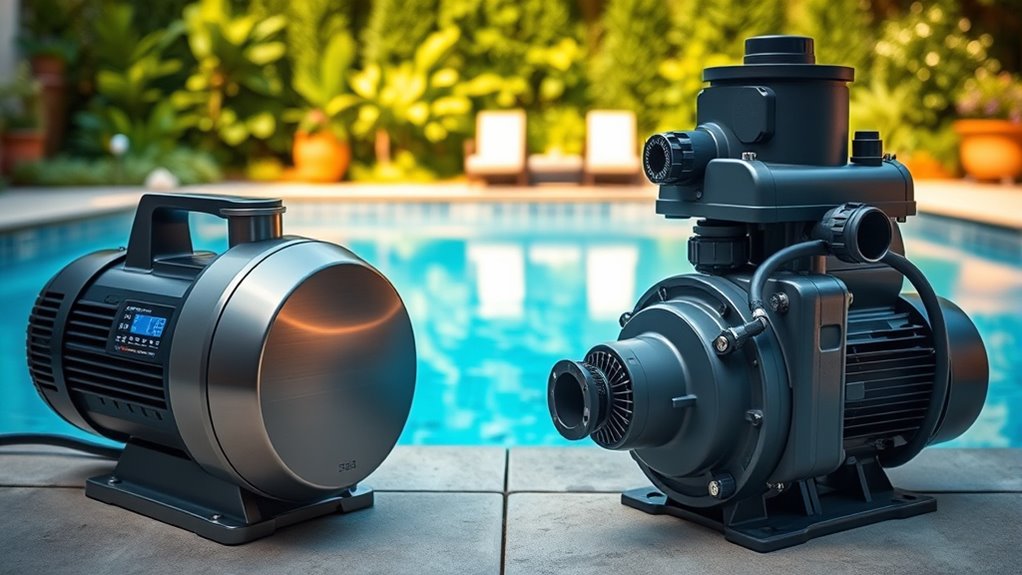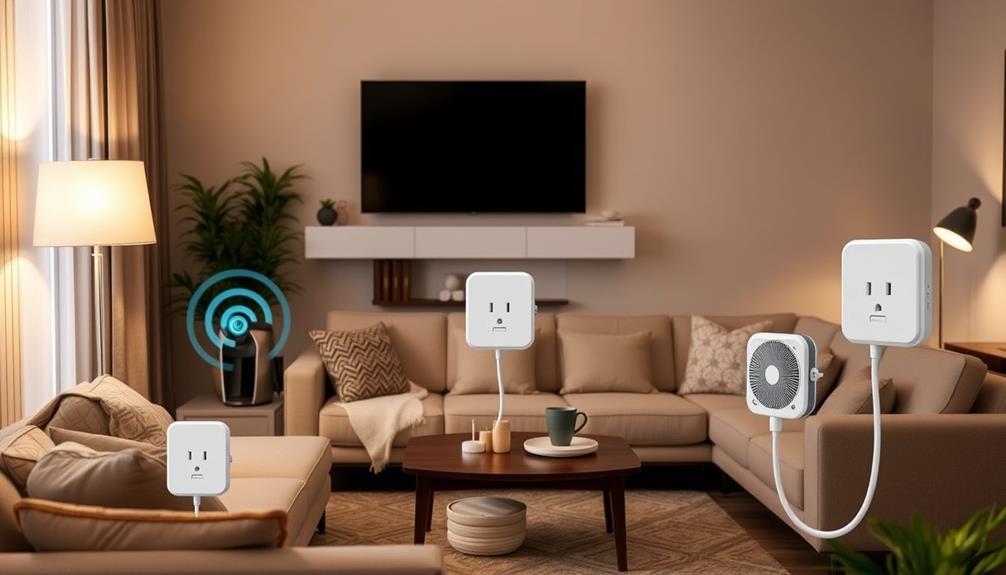Switching from a single-speed to a variable-speed pool pump can cut your energy use by up to 80%, profoundly lowering your utility bills and environmental impact. Variable-speed models adjust their power based on your pool’s needs, operating at slower speeds that use much less energy—sometimes just 12.5% of what single-speed pumps consume. This efficiency not only saves money but also reduces noise and wear. To discover detailed insights on how these pumps can benefit you, keep exploring further.
Key Takeaways
- Variable-speed pumps can reduce energy usage by up to 80–90% compared to single-speed pumps.
- They adjust motor speed precisely, decreasing power consumption exponentially per the Pump Affinity Law.
- Single-speed pumps consume 12–20 kWh daily, while variable-speed models use about 1.2–6 kWh.
- Running at lower speeds significantly lowers noise, emissions, and chemical use, benefiting the environment.
- Most owners recover higher upfront costs within two years due to substantial energy savings.
Comparing Energy Efficiency of Pump Technologies

When comparing the energy efficiency of pool pump technologies, the differences are remarkable. Single-speed pumps typically use between 1,500 to 2,500 watts, consuming 12 to 20 kWh daily and up to 4,800 kWh annually. In contrast, dual-speed and variable-speed pumps operate more efficiently, with variable models consuming as little as 150 to 1,500 watts, and daily use dropping to 1.2 to 6 kWh. This means a variable-speed pump can use roughly 80% less energy annually than a single-speed pump—around 600 kWh versus nearly 3,000 kWh. The constant high energy draw of single-speed pumps highlights their inefficiency, while variable-speed pumps adjust their power based on needs, considerably reducing overall energy consumption and costs. Additionally, Variable-speed pumps can be programmed to run only as long as necessary, further enhancing their energy-saving potential. Furthermore, advancements in pump technology have led to smarter and more adaptable systems that optimize energy use based on real-time pool requirements.
How Variable Speed Pumps Save Power
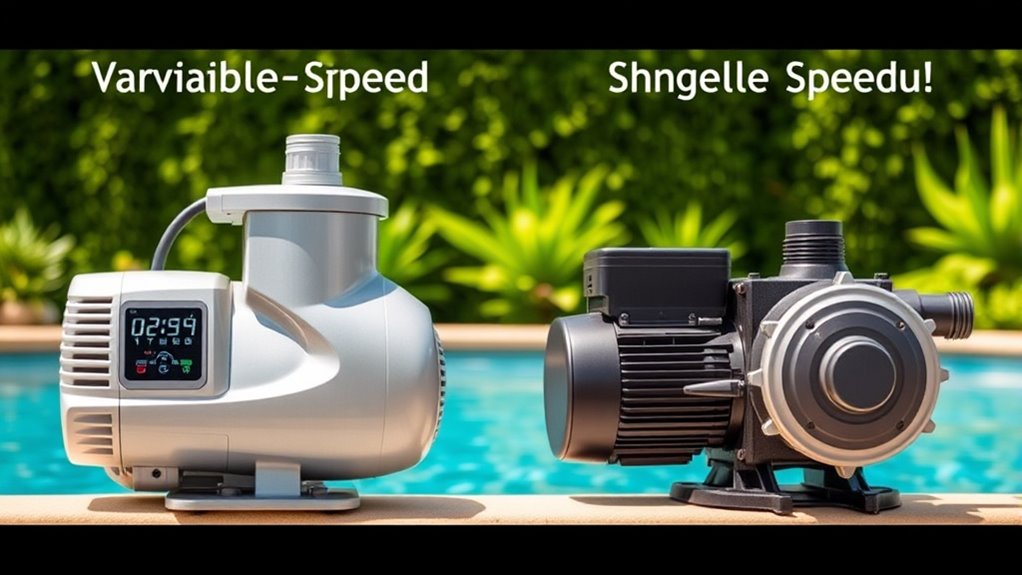
You can conserve a lot of energy with variable speed pumps because they adjust their speed precisely to match your pool’s needs. When you lower the speed, power consumption drops exponentially, meaning even small reductions can lead to big savings. By fine-tuning the flow, you ensure efficient operation while using less electricity overall. This is possible because variable speed pumps can be programmed to run at different speeds throughout the day, optimizing energy use based on current requirements. Additionally, integrating automation in business intelligence allows for smarter scheduling and operation adjustments, further enhancing energy efficiency. This adaptability aligns with personal development principles by promoting awareness and intentional control over your energy consumption.
Exponential Energy Savings
Variable speed pumps achieve remarkable energy savings because their power consumption decreases exponentially as flow rates are reduced. According to the Pump Affinity Law, power scales with the cube of pump speed. When you reduce motor speed to 50%, power drops to about 12.5%, not just half. For example, a single-speed pump at 66 gpm might use 2,000 watts, while a variable speed pump operating at 22 gpm consumes only around 116 watts, even with longer run times. Running slower, the pump uses roughly 2.2 kWh per turnover compared to 12.6 kWh for a single-speed. This exponential reduction in energy use means you can profoundly cut your pool’s daily energy consumption—often by 70-80%—and maximize efficiency without sacrificing performance. Energy efficiency is further enhanced when selecting pumps with smart technology that optimizes operation based on real-time needs. Additionally, selecting the right pump can also reduce operational costs over the long term by minimizing electricity bills and maintenance requirements.
Precise Speed Adjustment
By adjusting the motor speed precisely to match your pool’s circulation needs, variable-speed pumps considerably enhance energy efficiency. This fine-tuning prevents wasteful over-pumping and reduces power consumption. Running at lower speeds can cut energy use dramatically—sometimes as low as 1/8 of full-speed energy. Plus, you can tailor filtration and circulation to specific tasks, like overnight operation during low-use periods, saving more energy without sacrificing water quality. Programmable controls let you set multiple speed schedules, automatically switching for filtration, heating, or features like waterfalls. Integrated motor control guarantees smooth transitions without surges, optimizing power use. Fine-tuning flow rates also improves filtration, reduces pressure drops, and minimizes noise, all contributing to significant energy savings. Variable-speed pumps provide a sustainable option that benefits both your energy bill and the environment. Additionally, these pumps often incorporate advanced motor controls, which further enhance their efficiency and performance.
Cost Benefits of Upgrading to a Variable Speed Pump

Upgrading to a variable speed pool pump offers significant cost benefits that can make the investment worthwhile. Most owners recover the higher upfront cost within two years through energy savings. To illustrate:
- You can reduce your annual energy costs by up to 80-90% compared to single-speed pumps.
- Utility rebates and Energy Star certifications can further enhance savings.
- The quick payback period means you start saving money almost immediately, with costs decreasing over the pump’s lifespan.
- Incorporating energy-efficient technology into your poolside setup can elevate the overall aesthetic and enhance your outdoor experience.
Lower operating speeds during filtration cut energy use without sacrificing water quality. Plus, less heat and wear extend your pump’s life, reducing maintenance costs. Overall, the upgrade delivers ongoing financial and environmental benefits.
Performance and Operational Advantages
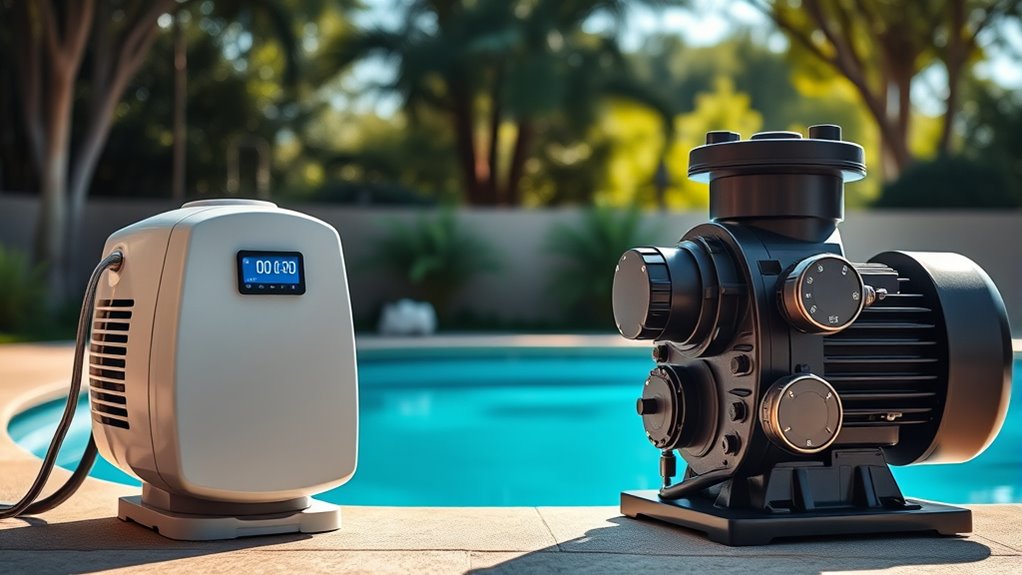
Variable-speed pumps give you precise control over flow rates, letting you match performance to your pool’s needs and minimize wear. They also run much quieter than single-speed models, creating a more peaceful environment. These advantages help guarantee your system operates efficiently and reliably over time. Additionally, choosing the right pump can contribute to energy savings and reduce operational costs. Energy efficiency is a key benefit of variable-speed models, helping to lower your electricity bills and support eco-friendly practices. By optimizing flow rates, they also reduce strain on the pump motor, which can extend its lifespan and further enhance system durability.
Precise Flow Control
Precise flow control in pool pumps guarantees consistent water movement, which is crucial for peak performance and system longevity. With variable-speed pumps, you can select exact flow rates tailored to your pool’s needs. This prevents overworking equipment, reducing wear and tear. Auto-regulated flow responds dynamically to debris buildup or blockages, maintaining steady circulation. This stability ensures: Enhanced filtration efficiency, leading to clearer, healthier water; optimized water features like waterfalls or fountains, avoiding under- or over-powering them; and reduced energy consumption by avoiding unnecessary high speeds. Additionally, flow regulation plays a vital role in maintaining proper chemical distribution and preventing algae growth.
Reduced Noise Levels
Since noise levels can substantially impact your poolside experience, choosing a pump that operates quietly offers clear benefits. Variable-speed pumps are much quieter than single-speed models, often producing noise levels comparable to a refrigerator or quiet conversation. While single-speed pumps typically run at 70–80 decibels—similar to a vacuum—variable-speed pumps can operate at 40–50 decibels at lower speeds. Running as low as 600 RPM, they generate markedly less noise than traditional models. At around 1,000 RPM, they produce approximately 50 decibels, increasing to about 66 decibels at 2,000 RPM. This quiet operation is especially advantageous during nighttime, reducing disturbances for you and your neighbors while maintaining effective pool performance.
Environmental Impact and Regulatory Compliance

Choosing a variable-speed pool pump can substantially reduce your environmental impact and help you stay compliant with regulations. These pumps lower energy consumption by 30% to 70%, cutting your carbon footprint markedly. Here’s how they make a difference:
- They decrease CO2 emissions by roughly 10 million tons annually nationwide, equivalent to removing 1.3 million cars.
- Their quieter operation reduces noise pollution, benefiting densely populated areas.
- Improved filtration efficiency at lower speeds lessens chemical use, supporting environmental health.
- The compact design of variable-speed pumps enhances ease of installation and storage, promoting more widespread adoption.
Technical Aspects and Optimal Usage Strategies
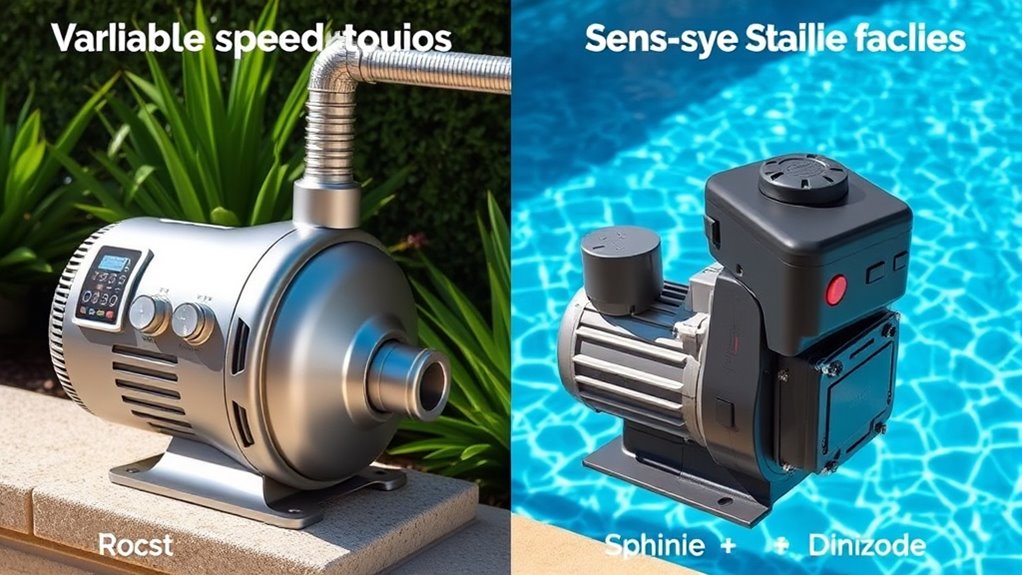
Variable speed pool pumps rely on advanced permanent magnet motor technology, which considerably enhances their efficiency and performance. These motors convert electrical energy into magnetic energy more effectively, achieving about 90% efficiency versus 30-70% for single-speed induction motors. This allows you to precisely control flow rates, matching pump operation to your pool’s needs and avoiding unnecessary energy use. Electronically adjustable speeds reduce mechanical and electrical strain, extending the pump’s lifespan. Many models feature integrated diagnostics and automated protection, helping you maintain maximum performance and prevent damage. To maximize efficiency, program your pump to operate at lower speeds during filtration, heating, or circulation, and reserve higher speeds for tasks like vacuuming. Properly leveraging these strategies ensures you get the most benefit from your variable speed pump. Additionally, understanding the energy impacts of different pump types can help you make informed decisions to reduce your overall energy consumption. Incorporating advanced motor technology can further improve energy savings and reliability over time.
Noise Levels and User Experience Enhancements

Variable-speed pool pumps operate more quietly than single-speed models, making them a significant upgrade for user comfort and neighborhood harmony. They produce about 25% less noise, typically around 40-50 decibels, compared to 60-70 decibels from single-speed pumps. Unlike the loud, constant hum of a 3,450 RPM single-speed motor, variable-speed models can run as low as 600 RPM, drastically reducing noise. Many models include noise-reducing features that further enhance quiet operation. Here’s what you can expect:
Variable-speed pool pumps run much quieter, producing about 25% less noise—around 40-50 decibels—compared to traditional models.
- A soft, low hum from inverter duty bearings and permanent magnet motors, less intrusive in your backyard.
- No abrupt starts or loud bursts, creating a more peaceful environment.
- Programmable settings that allow quiet operation during early mornings or late nights, enhancing overall user experience. Energy-efficient operation further reduces operational noise and environmental impact.
Frequently Asked Questions
How Long Does It Typically Take to Recoup the Cost of a Variable Speed Pump?
You can typically recoup the cost of a variable speed pump in less than two years through energy savings. Depending on your usage patterns, local energy prices, and pump size, some owners see payback even sooner. Since these pumps can save up to 83% on electricity costs annually, you’ll enjoy long-term savings and other benefits like quieter operation and reduced maintenance costs, making the investment worthwhile.
Are There Specific Pool Sizes or Types That Benefit Most From Variable Speed Pumps?
Think of your pool as a garden—some need gentle watering, others need a quick splash. Larger pools, especially in-ground ones, benefit most from variable speed pumps because they save up to 80% on energy, handling extended run times efficiently. Medium-sized pools also gain considerably by adjusting flow rates. If you have a big or commercial pool, switching to a variable speed pump can drastically cut costs and improve water quality.
Can Existing Single-Speed Pumps Be Easily Upgraded to Variable Speed Models?
Yes, you can easily upgrade your existing single-speed pump to a variable-speed model by replacing just the motor, often without re-plumbing. Make certain the new motor matches your pump’s frame size and consult manufacturer guidelines for compatibility. Most upgrades involve straightforward wiring and controls, allowing you to enjoy energy savings, quieter operation, and better automation. This retrofit is typically quick and cost-effective, making it a practical upgrade option.
What Maintenance Differences Exist Between Variable Speed and Single-Speed Pumps?
You’ll notice that variable-speed pumps need less frequent maintenance since their advanced technology reduces wear and tear. They require occasional software updates and system inspections but generally last longer and run more efficiently. Single-speed pumps, on the other hand, endure more frequent repairs due to constant high RPM operation, which accelerates part degradation. They are mechanically simpler but often need quicker attention to mechanical issues, making maintenance more frequent overall.
How Do Inverter Pumps Compare in Energy Savings to Fixed-Speed Variable Pumps?
Inverter pumps save you more energy than fixed-speed pumps because they adjust their speed based on your pool’s needs, reducing power consumption during low-demand periods. While fixed-speed pumps run at full power constantly, inverter models optimize operation, cutting energy use by up to 90%. This efficiency not only lowers your electricity bills but also minimizes environmental impact, making inverter pumps the smarter, more sustainable choice for long-term savings.
Conclusion
Choosing a variable-speed pump is like planting a seed that grows into a greener future. It’s not just about saving energy or cutting costs—it’s about nurturing a world where your pool’s harmony with the environment blossoms. By embracing this upgrade, you become a steward of sustainability, turning everyday choices into a legacy of care. Let your pool’s quiet, efficient flow symbolize your commitment to a cleaner, brighter tomorrow.
